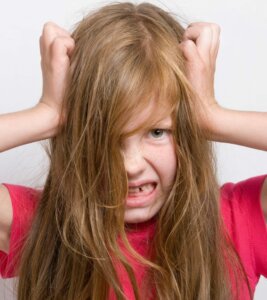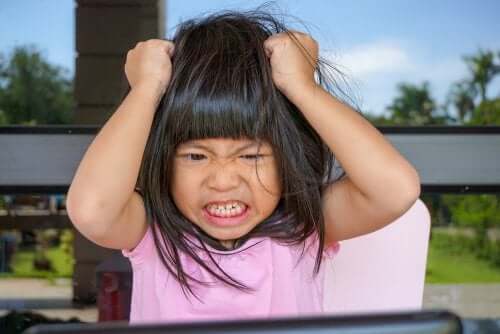Trichotillomania in Children: What is it?

Trichotillomania in children is an impulse control disorder in which a child repeatedly pulls out their own hair. Although it’s a rare condition, it can be scary for both the child and their parents, given how peculiar it is. Therefore, it’s important to learn about the characteristics of this disorder.
Normally, we see that the head is the most affected area of the body. However, children can also pull hair out of other parts of their bodies, like their eyebrows, eyelashes, armpits or pubis.
You should know that these actions aren’t premeditated and that your child can’t control them. It’s an irresistible impulse, so it’s useless to ask your child to explain this behavior or to yell or punish them for doing it.
What is trichotillomania in children?
Trichotillomania is the constant pulling of hair from one’s body. This action occurs after a growing sense of tension that the child experiences, which they relieve by pulling out their hair.
So, before they pull their hair out (or if they try to avoid doing it), they feel very uncomfortable. However, when they do the impulsive behavior, that discomfort is replaced by feelings of gratification and satisfaction.
Trichotillomania usually begins during periods of stress or tension in the child’s life. They resort to this behavior as a type of relief.
Also, they may use it to calm their nerves when they’re studying or doing homework, for example. However, over time, they start to generalize the behavior and will pull their hair out when they’re in stress-free situations, like when they’re bored or alone.

The consequences of this behavior are significant and can greatly affect your child’s life. The most obvious consequence is hair loss, which can lead to bald spots, areas with hair of different lengths and scalp wounds.
In addition, your child may develop serious digestive problems if they eat the hair they pull out (trichophagia). In that case, they may also experience intestinal obstruction, nausea, vomiting and lack of nutrients.
What causes it?
There are several factors that can cause trichotillomania. For example, there may be a genetic or hereditary component, or it could be the result of an imbalance of neurotransmitters. However, the psychological aspects definitely play a role.
Events such as moving, parental divorce, or any other sudden change in the child’s environment can trigger trichotillomania. Children, by definition, have poor impulse control. If we couple that with a stressful situation and a lack of coping tools, it’s clear why this problem may arise.
Although it starts as an innocent behavior that your child uses for stress relief, it can end up becoming a chronic condition. In addition, researchers have found a relationship between trichotillomania and other conditions such as obsessive-compulsive disorder, anxiety, depression or onychophagia (nail biting).
Is there treatment?
Fortunately, there are techniques we can use to address this disorder. Cognitive behavioral psychotherapy is the most effective treatment because it has been shown to reduce and eliminate trichotillomania in children.

This procedure is based around the fact that the child doesn’t consciously or deliberately pull their hair out. Instead, this behavior is a habit and is an automatic behavior. For example, they’ll do it when they’re bored or doing homework, and they may not even notice they’re doing it.
The goal is to help make your child aware of when they’re doing it and to help them control their impulses. The habit reversal technique can help to accomplish this. It consists of establishing a physical response incompatible with pulling out their hair that your child should do when they feel the impulse coming on.
These types of interventions have produced very good results, but parent collaboration is essential. If your child is suffering with this condition, don’t be alarmed. Instead, help your child understand that they’re not the only one. Let them know they’re not alone and that you can give them some tools to help.
Most importantly, don’t blame, punish or reproach them for this behavior. Remember, they can’t control it. In addition, going to a child psychologist can make a difference in their quality of life.
Trichotillomania in children is an impulse control disorder in which a child repeatedly pulls out their own hair. Although it’s a rare condition, it can be scary for both the child and their parents, given how peculiar it is. Therefore, it’s important to learn about the characteristics of this disorder.
Normally, we see that the head is the most affected area of the body. However, children can also pull hair out of other parts of their bodies, like their eyebrows, eyelashes, armpits or pubis.
You should know that these actions aren’t premeditated and that your child can’t control them. It’s an irresistible impulse, so it’s useless to ask your child to explain this behavior or to yell or punish them for doing it.
What is trichotillomania in children?
Trichotillomania is the constant pulling of hair from one’s body. This action occurs after a growing sense of tension that the child experiences, which they relieve by pulling out their hair.
So, before they pull their hair out (or if they try to avoid doing it), they feel very uncomfortable. However, when they do the impulsive behavior, that discomfort is replaced by feelings of gratification and satisfaction.
Trichotillomania usually begins during periods of stress or tension in the child’s life. They resort to this behavior as a type of relief.
Also, they may use it to calm their nerves when they’re studying or doing homework, for example. However, over time, they start to generalize the behavior and will pull their hair out when they’re in stress-free situations, like when they’re bored or alone.

The consequences of this behavior are significant and can greatly affect your child’s life. The most obvious consequence is hair loss, which can lead to bald spots, areas with hair of different lengths and scalp wounds.
In addition, your child may develop serious digestive problems if they eat the hair they pull out (trichophagia). In that case, they may also experience intestinal obstruction, nausea, vomiting and lack of nutrients.
What causes it?
There are several factors that can cause trichotillomania. For example, there may be a genetic or hereditary component, or it could be the result of an imbalance of neurotransmitters. However, the psychological aspects definitely play a role.
Events such as moving, parental divorce, or any other sudden change in the child’s environment can trigger trichotillomania. Children, by definition, have poor impulse control. If we couple that with a stressful situation and a lack of coping tools, it’s clear why this problem may arise.
Although it starts as an innocent behavior that your child uses for stress relief, it can end up becoming a chronic condition. In addition, researchers have found a relationship between trichotillomania and other conditions such as obsessive-compulsive disorder, anxiety, depression or onychophagia (nail biting).
Is there treatment?
Fortunately, there are techniques we can use to address this disorder. Cognitive behavioral psychotherapy is the most effective treatment because it has been shown to reduce and eliminate trichotillomania in children.

This procedure is based around the fact that the child doesn’t consciously or deliberately pull their hair out. Instead, this behavior is a habit and is an automatic behavior. For example, they’ll do it when they’re bored or doing homework, and they may not even notice they’re doing it.
The goal is to help make your child aware of when they’re doing it and to help them control their impulses. The habit reversal technique can help to accomplish this. It consists of establishing a physical response incompatible with pulling out their hair that your child should do when they feel the impulse coming on.
These types of interventions have produced very good results, but parent collaboration is essential. If your child is suffering with this condition, don’t be alarmed. Instead, help your child understand that they’re not the only one. Let them know they’re not alone and that you can give them some tools to help.
Most importantly, don’t blame, punish or reproach them for this behavior. Remember, they can’t control it. In addition, going to a child psychologist can make a difference in their quality of life.
All cited sources were thoroughly reviewed by our team to ensure their quality, reliability, currency, and validity. The bibliography of this article was considered reliable and of academic or scientific accuracy.
- Jaramillo-Borges, Y. M. (2007). Tricotilomanía, tricofagia y el Síndrome de Rapunzel. Acta Médica Costarricense, 49(1), 4-5.
- Torales, J., García Franco, Ó., & Leguizamón, V. (2011). Tricotilomanía pediátrica: una puesta al día. Med. actual, 12(1), 23-28.
- Sanz, E. (2019, 31 octubre). El entrenamiento en inversión de hábito para los tics nerviosos. Recuperado de https://lamenteesmaravillosa.com/entrenamiento-en-inversion-de-habito-para-los-tics-nerviosos/
This text is provided for informational purposes only and does not replace consultation with a professional. If in doubt, consult your specialist.








